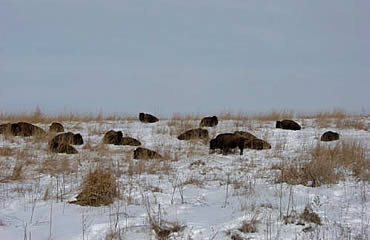“Home on the Range,” a favorite song of school children and lovers of wide open spaces, is a bit inaccurate when it comes to one proper, scientific name. There aren’t any buffalo on the range, but there are American bison.
Explorers, French fur trappers and settlers first named these enormous creatures. They used a word in spoken French which evolved into the word “buffalo.” It was also the same word they used to identify an animal they were most familiar with, oxen.
The name stuck, and it’s so commonly used, most won’t wonder if there is a difference, but, of course, there is.
Bison have large shoulder humps, short horns and are found in North America and Europe. Buffaloes do not have shoulder humps, but possess long sweeping horns, and are found in Africa and Asia.
There are two American bison subspecies—the plains bison which is smaller in size and has a rounded hump, and the wood bison, the larger of the two.
Once, bison in enormous herds estimated between 30 to 60 million animals roamed across most of North America. They ranged as far north as the Great Bear Lake in Canada, south through the Mexican states of Durango and Nuevo Leon, and across the American Great Plains, extending along the entire Atlantic Seaboard. Now they are found in parks such as Yellowstone, on preserves and in privately owned herds.
A bison is difficult to ignore, because they are enormous.
Males (bulls) can weigh over 2,000 pounds; that’s as heavy as a small, economy car. They are tall, too. From the ground to the top of the shoulder, male bison range from six to seven feet tall. Females (cows) are half the weight and five to six feet tall at the shoulder.
 Both males and females have horns, beards and a large shoulder hump of muscle that supports the bison’s head and neck.
Both males and females have horns, beards and a large shoulder hump of muscle that supports the bison’s head and neck.
They are remarkably fleet of hoof, too. Neither slow nor awkward, bison can run as fast as horses and can easily jump six-foot fences. Although bison may resemble a sturdy and slow tank, they move like race cars. Some have been recorded running at nearly 40 miles per hour.
One interesting bison habit during late fall and winter months is called “horning.” Biologists believe the activity is a defense against biting insects when they rub their horns, heads, neck and shoulders against aromatic cedar and pine trees and saplings.
Bison were important animals for Native Americans, and some believed their ancestors came from bison. When a bison was killed, it was treated with great respect.
The skins were used for clothing and shelter; the meat was eaten and bones were used to make tools and weapons. Horns became containers to carry food, water, supplies and gun powder. Nothing was wasted, not even the droppings which when dried became fuel for fires.
Settlers and hunters quickly realized how valuable bison were. As the American West grew, and railroads were built on land once only occupied by wildlife, the number of bison killed vastly exceeded the number born.
Expansion of the railroads made it easier to transport bison hides, and bison were killed in large number by commercial hunters. When drought made water difficult to find, and diseases spread by settlers’ domestic cattle and sheep infected bison herds, the bison populations plummeted nearly to extinction.
By the time Idaho passed the first law to protect bison in 1864, it was too late. Bison had already disappeared from the state. Although other states also passed laws to protect bison, by 1889 there were only about 1,000 bison in all of North America, and only two free-roaming herds in the United States.
It was then that Samuel Walking Coyote of the Kalispel tribe, also known as the Pend d’Oreille, captured orphaned bison calves and started a herd, then helped two other men to start a herd which became the largest of its kind with 300 bison.
By 1902, 20 bison were sent to Yellowstone National Park, which is spread across the states of Wyoming, Idaho and Montana. Today visitors to the park can still see the descendants of that herd. There are also many privately owned herds raised for meat production.
Visitors to Yellowstone, as well as to the U.S. and Canadian parks with bison herds, should be aware bison are among the most dangerous animals in the park, and injure more visitors than bears. They are known to charge, the result being goring puncture wounds, broken bones and abrasions.
—Contributed by the Idaho Department of Fish and Game
—Photos courtesy USFWS